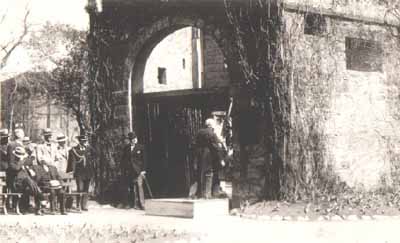Forts Rouge, Garry and Gibraltar National Historic Site of Canada
Winnipeg, Manitoba

Historical image
© Agence Parcs Canada / Parks Canada Agency, c. 1925.
Address :
130 Main St., Winnipeg, Manitoba
Recognition Statute:
Historic Sites and Monuments Act (R.S.C., 1985, c. H-4)
Designation Date:
1924-06-04
Dates:
-
1738 to 1836
(Construction)
Event, Person, Organization:
-
Fur Trade
(Event)
-
Pierre Gaultier de Varennes et de La Vérendrye
(Person)
-
Hudson's Bay Company
(Builder)
-
North West Company
(Builder)
Other Name(s):
-
Forts Rouge, Garry and Gibraltar
(Designation Name)
Research Report Number:
2009-CED/SDC-007
Plaque(s)
Existing plaque: on gateway to Upper Fort Garry 130 Main St., Winnipeg, Manitoba
Near this site stood the following forts: Fort Rouge, under La Verendrye, 1738; Fort Gibraltar, of the North West Company, 1810, became Fort Garry of the Hudson's Bay Company, 1822; replaced by Upper Fort Garry, of stone, bugun 1835, extended in 1850's when this gateway was erected, demolished 1882.
Description of Historic Place
Forts Rouge, Garry and Gibraltar National Historic Site of Canada is located on three different positions at the forks of the Red and Assiniboine rivers in downtown Winnipeg, Manitoba. The only original surviving above-ground element is the north gate of Fort Garry II located in Upper Fort Garry Park, the walls of which have been partially reconstructed. The sites of the two forts Gibraltar and the first Fort Garry have been identified adjacent to Union Station, while the site of Fort Rouge is believed to be on South Point, immediately south across the Assiniboine River. Official recognition refers to the footprint of Fort Garry II, the known archaeological remains of Fort Gibraltar I, Fort Gibraltar II and Fort Garry I, and the probable location of Fort Rouge.
Heritage Value
Forts Rouge, Garry and Gibraltar were designated national historic sites of Canada in 1924 because of: their connection with the three phases of the fur trade, beginning with the construction of Fort Rouge in 1738 and ending with the demolition of Upper Fort Garry.
Located at the forks of the Assiniboine and Red rivers, Forts Rouge, Garry and Gibraltar illustrate the evolution of the fur trade in the west, from expansion westward to the dominance of the North West Company and the Hudson’s Bay Company.
Built in 1738, Fort Rouge was part of Pierre Gaultier de Varennes et de la Vérendrye’s westward expansion of the fur trade on behalf of France, and was used as a trading post for the local Aboriginals. The fort may have operated for only one season, and by 1807, Fort Gibraltar was built near its site by the North West Company. It became the company’s main fort in the interior and served as a pemmican post, providing supplies further inland, until it was destroyed in 1816 during a conflict with the Hudson’s Bay Company. When the two companies merged in 1821, the fort was rebuilt as Fort Garry. Built on or near the site of Fort Gibraltar, Fort Garry became the chief fort at Winnipeg, although its unstable position near the river’s edge required it to be moved to higher ground by 1836. Partially demolished in 1882, the northern gate of Fort Garry II constitutes the only above ground remains of the succession of forts around the confluence of the Red and Assiniboine rivers.
Sources: Historic Sites and Monuments Board of Canada, Minutes, 1924, March 2009.
Character-Defining Elements
Key elements that contribute to the heritage character of the site include: the location of the forts at the confluence of the Assiniboine and Red rivers; the spatial relationships between the fort sites, illustrating successive constructions and phases of the fur trade; the northern gate of Fort Garry II in its siting, construction, volume, massing and materials, as well as evidence of the original north wall of the fort; evidence of the locations of the two Forts Gibraltar and the first Fort Garry; evidence of the possible location of Fort Rouge; the integrity of any surviving or as yet unidentified archaeological remains which may be found within the site in their original placement and extent; viewscapes between the Fort Rouge site and the site of Fort Gibraltar and from the forts to the river.